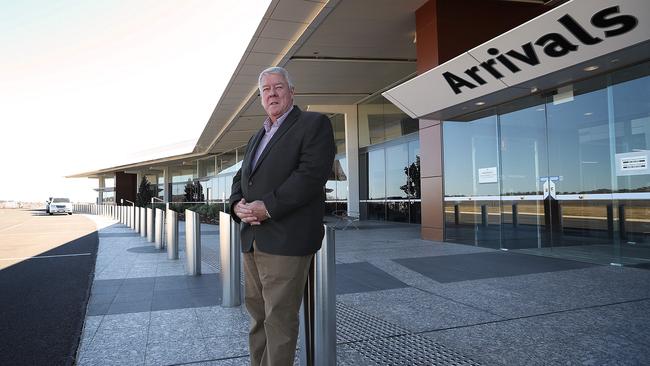Inland export port becomes a reality backed by links and land
Three pieces of massive infrastructure in road, rail and air are transforming Toowoomba into potentially Australia’s biggest inland port.

Three pieces of massive infrastructure in road, rail and air are transforming the regional city of Toowoomba on Queensland’s Darling Downs into potentially Australia’s biggest inland port.
Toowoomba already has Australia’s latest airport at Wellcamp, about 25 kilometres west of the city, and by the end of the year a new road bypass of the city will make road transport far more efficient, while the Inland Rail project from Melbourne to Brisbane will run through the outskirts of the city when it is due to be finished in 2025.
The only completed part of this trifecta, Toowoomba Wellcamp Airport, has been making a mark, with Cathay Pacific running a weekly freight flight from Wellcamp to Hong Kong, carrying mostly fruit and vegetables from the local Darling Downs region and the Lockyer Valley as well as some manufactured goods.
But better road and rail linkages coming on stream from not just the Darling Downs but also mid-western NSW and northern Victoria means that those areas could use Toowoomba instead of Sydney or Melbourne as an export point, making the city a major inland port.
“It’s all coming together at the right time for us,” Toowoomba Regional Council Mayor Paul Antonio says.
“Having the airport built completely locally gave us a huge boost. This community now believes in itself,’’ Antonio says.
“And there’s been talk about a Second Range Crossing [the bypass] for years, but everything lined up at the right time for us. Ian Macfarlane, who was the local member at the time, was quite close to Tony Abbott when he was prime minister, and in Brisbane, we had an LNP government who were keen to work with them.
“And the rail is coming along at the right time as well.”
Brisbane is only 130km to the east of Toowoomba, but for most of the latter’s 180-year history, the orientation of the city has been to the rich grazing and agricultural fields of the Darling Downs to its west.
It stands high in the Great Dividing Range, with most of the city to the west of the area’s range peak and only a few streets to the east.
The peak area divides the city in more ways than one — when rain falls on the eastern side of the city the water flows 170km east to Moreton Bay near Brisbane, while rain which falls only a few streets away to the west of the range flows into Gowrie Creek, then the Condamine River, which is part of the Murray-Darling river system, and then travels 3000km to the sea near Adelaide.
The three pieces of infrastructure coming within a 10-year period will provide synergies that will radically change Toowoomba and its role in the broader regional economy.
Toowoomba’s main advantage is land — plenty of it, and relatively inexpensive.

The first synergy is between rail and air. Toowoomba Wellcamp Airport, privately built by the Wagner family, has a huge parcel of land around it which will be used for a multi-modal facility to store primary produce and manufactured items before they are flown to Asia and other parts of the world.
John Wagner, a director of construction-materials and mining-services group Wagners, says work will start late this year on a $60 million facility at the airport.
“We are now the only regional airport in Australia with international connections and there is the opportunity for more,” he says.
“We are ideally situated to be an inland port. When the railway line is finished — and that’s only going to be in a few years’ time — then produce from northern Victoria and southern NSW will be able to come right into the airport before it is flown overseas,’’ Wagner says.
“Our big advantage is that our land at Wellcamp has no cadastral [surveyed and legally limited] boundaries. It means there’s plenty of room to grow well into the future.”

Other parts of the Darling Downs will also benefit from the infrastructure upgrade. Paul McVeigh, the Mayor of Western Downs Shire, says in the short term the Toowoomba road bypass is the most important of the three pieces, but in the long term, all will benefit the entire Downs region.
“We actually call it the Western Downs Connection Road and not the Toowoomba bypass,” he jokes. “But it will mean for us and everyone on the downs that the trip to Brisbane will be 40 minutes shorter by car and 80 minutes shorter by truck.
“We have a big interest in an upgraded rail line as well, as that will help develop our coal industry. And the airport is very important for the development of our tourism industry.”
As well as building the $200m airport, Wagners, a company founded by four Wagner brothers in 1989 and now one of the Australia’s biggest regional companies, is looking to be involved in the construction of new sections of what will be the Inland Railway.
It is part of a consortium bidding for construction of the railway line that will run in Queensland from the state border near Goondiwindi to Toowoomba and then to south of Brisbane, where it will connect with the coastal railway network.
Engineering work on this new line has already started, and the steady increase in work will provide a handy transition for Toowoomba’s growing army of trades workers and contractors who have been able to flit from one project to another in the past few years.
From the start of this decade, building infrastructure for the coal-seam-gas fields of the Surat Basin, about 200km to the west of Toowoomba, provided a lot of work for Toowoomba contractors, but most of the construction work was finished about 2015 and the gas fields are now in a production phase.
But around that time, work on the Second Range Crossing bypass started, and that project has at its height employed 1250 people directly and, even now as it is nearing the end, there are still 720 workers.

When work on the road bypass winds down, then the design and construction of the railway will employ many of these contractors.
Aside from construction, the Darling Downs is economically one of the most stable regions in Australia, being based on agriculture, and to a lesser degree, mining. The Darling Downs and South West regions lifted their regional product in 2016-17 by 8 per cent to a reported $18.7 billion.
Toowoomba is also a large regional centre where the biggest employers, as in many large cities, are health and education.
The city’s regional population of 166,000 people is forecast to reach 230,000 by 2031, while its regional economy is forecast to grow from $10.47bn last year to $25bn. A sign of confidence is the $500m redevelopment of the Grand Central Shopping Centre in the CBD.
In the most recent 12 months for which figures are available, its economy grew at 6.2 per cent, when its population grew by just 1 per cent.

Antonio points out that this is a change from the recent economic history of Queensland, where economic growth largely depended on population growth.
“That’s where we’re different — our business growth doesn’t depend on population growth,” he says.
“We’ve had significant growth around Toowoomba. I think Highfields [on Toowoomba’s northern outskirts] is one of Australia’s quickest-growing areas. But we feel that we could certainly accommodate more population growth now.”
Toowoomba Chamber of Commerce president Jo Sheppard says the combined impact of the three big infrastructure changes is to make transport on the Darling Downs more efficient, at a time when such efficiencies are being demanded internationally.
“What we have here in what a good deal of the rest of the world wants,” she says.
“But getting it to market in an efficient and timely fashion is important, and we’re well aware that we’re competing internationally on that front. These three projects are taking Toowoomba to the next level.”
Sheppard says that while the airport has the potential to increase exports, the domestic connections mean, with daily flights to Sydney and Melbourne, a changing dynamic within Toowoomba.
“The hospitals, for example, are finding it easier to get specialists, as they now find it easier to nip back to Sydney or Melbourne for the weekend. It’s over two hours drive to Brisbane Airport — that’s over four hours you’re saving,’’ Sheppard says.
“Those sort of lifestyle aspects are very important in attracting senior people. We’re getting more people in the finance sector from Sydney and Melbourne who are settling in Toowoomba as well.
“Connectivity is the key. But that’s not just better airports and roads and rail, it’s also digital connectivity, and that’s an area that’s coming together for us as well.”
Toowoomba is connected to the National Broadband Network, and while there have been some complaints about the NBN, it also led to the laying down of a high-speed fibre-optic cable, which is encouraging establishment of new businesses.
One such business is the Pulse Data Centre, which stores backup data for enterprises all around Australia in a highly secure facility which opened in April this year in an open field to the west of Toowoomba. The centre is a Fort Knox of data to guarantee security for clients, with high fences and electronic passes necessary for any movement within the building.
Pulse Data Centre manager Peter Blunt says while there is an international trend towards data centres in regional areas, this was the first of its size in regional Australia.
“The cost of land here is far cheaper than in the major cities, especially the CBDs, and our ongoing costs will be cheaper when we get our own power plant. Plus it is a lot easier to scale up,” he says.
As with the airport, a big advantage is inexpensive and plentiful land. The data centre is planned to be the cornerstone of a proposed technology park which will capitalise on the high-speed fibre-optic communications links to the data centre and within the park.
The group behind the development, the Toowoomba-based FKG group, plans for the park to be self-sufficient in energy, and construction of its own power station fired by both gas and solar is due to start next year.
The FKG Group is based on the Gardner family who, like the Wagners, are a Darling Downs building and construction company which has grown with the region in the past 40 years.



